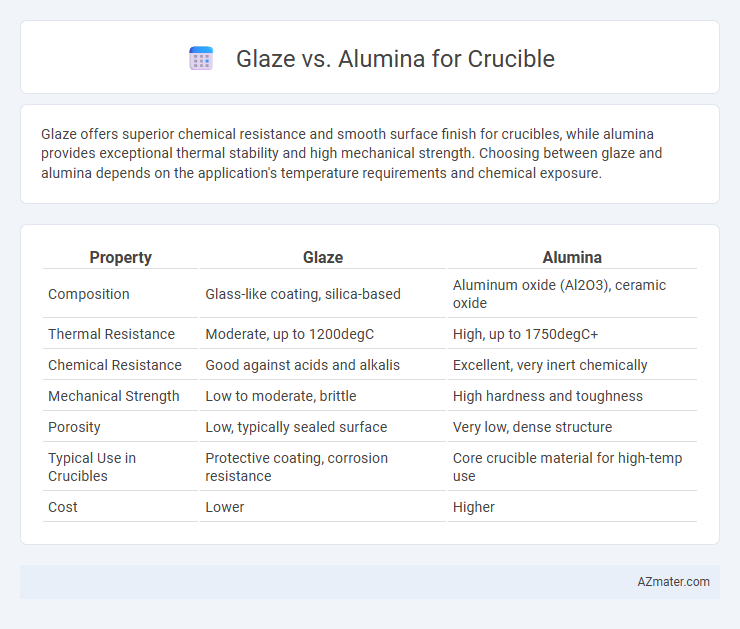Glaze offers superior chemical resistance and smooth surface finish for crucibles, while alumina provides exceptional thermal stability and high mechanical strength. Choosing between glaze and alumina depends on the application's temperature requirements and chemical exposure.
Table of Comparison
| Property | Glaze | Alumina |
|---|---|---|
| Composition | Glass-like coating, silica-based | Aluminum oxide (Al2O3), ceramic oxide |
| Thermal Resistance | Moderate, up to 1200degC | High, up to 1750degC+ |
| Chemical Resistance | Good against acids and alkalis | Excellent, very inert chemically |
| Mechanical Strength | Low to moderate, brittle | High hardness and toughness |
| Porosity | Low, typically sealed surface | Very low, dense structure |
| Typical Use in Crucibles | Protective coating, corrosion resistance | Core crucible material for high-temp use |
| Cost | Lower | Higher |
Introduction to Crucible Materials
Crucibles are essential containers used in high-temperature applications for melting and casting metals, ceramics, and glass, with material choice directly impacting performance and durability. Glaze coatings provide a smooth, non-porous surface that enhances chemical resistance and ease of cleaning, while alumina crucibles offer superior thermal stability and high melting points above 2000degC, making them ideal for extreme temperature processes. Selecting between glaze and alumina involves evaluating factors such as thermal conductivity, chemical inertness, and mechanical strength to match specific industrial or laboratory requirements.
Understanding Glaze in Crucible Manufacturing
Glaze in crucible manufacturing serves as a critical protective coating that enhances thermal resistance and prevents chemical reactions between the crucible material and molten substances. Unlike alumina, which constitutes the crucible's primary refractory material known for high melting point and mechanical strength, glaze provides a smooth, impermeable surface that minimizes contamination and improves durability. Optimizing glaze composition and application techniques significantly impacts the crucible's performance, longevity, and compatibility with various metallurgical processes.
What is Alumina and Its Role in Crucibles?
Alumina, or aluminum oxide (Al2O3), is a highly durable ceramic material essential in crucibles for its exceptional thermal stability and resistance to corrosion. Its high melting point of approximately 2072degC makes alumina crucibles ideal for high-temperature applications in metal casting, glass production, and chemical processing. The material's resistance to chemical attack ensures longevity and purity in melting processes, outperforming glazed crucibles that may degrade under extreme heat or reactive conditions.
Thermal Performance: Glaze vs Alumina
Glaze coatings on crucibles provide a smoother surface that enhances thermal shock resistance but may have lower overall heat tolerance compared to alumina crucibles, which exhibit superior thermal stability and can withstand temperatures exceeding 1700degC. Alumina's high melting point and excellent thermal conductivity make it ideal for applications involving rapid temperature changes and prolonged high-heat exposure. In contrast, glazed crucibles are better suited for moderate temperature processes requiring chemical resistance and surface durability.
Chemical Resistance Comparison
Glaze and alumina differ significantly in chemical resistance when used for crucibles, with alumina exhibiting superior resistance to aggressive chemicals, including strong acids and bases, due to its inert ceramic composition. Glazed crucibles provide a protective, glass-like coating that resists moderate corrosion but can degrade under prolonged exposure to harsh chemicals or thermal shock. Alumina's high purity and stable crystal structure make it ideal for high-temperature applications requiring sustained chemical durability and corrosion resistance.
Mechanical Strength and Durability
Glaze coatings enhance crucibles by providing a smooth, protective layer that improves resistance to chemical corrosion and surface wear, contributing to moderate mechanical strength. Alumina crucibles exhibit superior mechanical strength and exceptional durability due to their high alumina content, which withstands thermal shock, abrasion, and mechanical stress more effectively. The combination of alumina's intrinsic toughness and resistance to high temperatures makes it the preferred choice for demanding industrial applications requiring long-lasting crucibles.
Temperature Limits: Glaze vs Alumina Crucibles
Alumina crucibles offer superior temperature resistance, typically withstanding continuous use up to 1700degC, making them ideal for high-temperature applications in metal casting and chemical reactions. Glaze crucibles, coated with a glassy finish, generally withstand lower temperatures around 900degC to 1100degC, limiting their use to less intense thermal processes. The choice between glaze and alumina depends on the required thermal endurance and chemical compatibility in laboratory or industrial settings.
Cost and Availability Analysis
Alumina crucibles typically cost more due to their superior high-temperature resistance and durability, making them ideal for industrial and laboratory applications requiring extended use. Glaze-coated crucibles tend to be more affordable and widely available, benefiting from mass production and simpler material requirements. Availability of alumina crucibles is often limited to specialized suppliers, while glazed crucibles can be found through broader distribution channels, impacting procurement decisions based on budget and urgency.
Applications Best Suited for Glaze and Alumina Crucibles
Glaze crucibles excel in applications requiring chemical inertness and resistance to contamination, making them ideal for melting glass, metal alloys, and holding strong acids or bases in laboratory settings. Alumina crucibles are best suited for high-temperature processes such as metal and ceramic melting, calcination, and sintering due to their exceptional thermal stability and mechanical strength. Selecting glaze or alumina crucibles depends on specific thermal, chemical, and mechanical demands, with glaze favored for corrosion resistance and alumina chosen for extreme heat tolerance.
Choosing the Right Crucible: Key Considerations
Selecting between glaze and alumina crucibles depends on desired thermal stability and chemical resistance; alumina crucibles offer superior high-temperature endurance up to 1750degC and excellent inertness against aggressive molten metals and slags. Glaze crucibles provide a cost-effective solution with moderate thermal resistance but may degrade under extreme temperature cycles or corrosive environments. Consider factors such as maximum operating temperature, chemical compatibility, and longevity to ensure optimal crucible performance in laboratory or industrial applications.

Infographic: Glaze vs Alumina for Crucible
 azmater.com
azmater.com